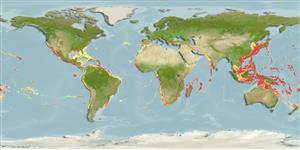Common names from other countries
Classification / Names / Names
Nama-nama umum | Sinonim (persamaan) | Catalog of Fishes (gen., sp.) | ITIS | CoL | WoRMS
Environment: milieu / climate zone / depth range / distribution range
Ekologi
Pelagis, permukaan; kisaran kedalaman 0 - 677 m (Ref. 83943). Temperate; 9°C - 18°C (Ref. 1812); 60°N - 48°S, 98°W - 175°W
Cosmopolitan.
Length at first maturity / Size / Weight / umur
Maturity: Lm ? range ? - ? cm Max length : 1.0 cm BL jantan/; (Ref. 2255)
One of the smallest chaetognaths (Ref. 2255). Maximum depth from Ref. 116105. This is an oceanic epiplanktonic species (Refs. 3702, 116362). Also mesoplanktonic, semi-neritic, and found in the outer continental shelf (Ref. 116105). Epipelagic (Ref. 116365).
Life cycle and mating behavior
Kematangan | Reproduksi, perkembang biakan | Pemijahan | telur-telur | Fecundity | Larva
Members of the phylum Chaetognatha are hermaphroditic. Mating behavior: A preliminary visual signaling behavior for species recognition is observed to prevent predation. Life cycle: Eggs directly develop into miniature adults (hatchlings).
rujukan utama
Acuan | Koordinator | mitra
Pierrot-Bultz, A.C. and K.C. Chidgey. 1988. (Ref. 2255)
Status IUCN Red List (Ref. 130435)
status CITES (Ref. 108899)
Not Evaluated
Not Evaluated
penggunaan manusia
| FishSource |
Alat, peralatan
informasi lanjut
Umur / SaizPertumbuhanpanjang-beratpanjang-panjangMorfologiLarvaKelimpahan
Sumber internet
Estimates based on models
Preferred temperature
(Ref.
115969): 15 - 28.2, mean 25.6 (based on 1385 cells).
keancaman
Low vulnerability (10 of 100).
kategori harga
Unknown.
